平狄克微观经济学(英文)PPT
合集下载
Chapter 9-The Analysis of Competitive Markets 平狄克微观经济学课件(英文)
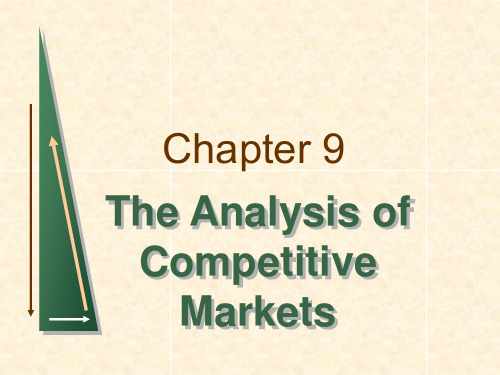
The Efficiency of a Competitive Market Minimum Prices
Chapter 9
Slide 2
Topics to be Discussed
Price Supports and Production Quotas Import Quotas and Tariffs The Impact of a Tax or Subsidy
Producer surplus is the total benefit or revenue that producers receive beyond what it cost to produce a good.
Chapter 9
Slide 4
Consumer and Producer Surplus
suffers a net loss from
price controls.
S
B
P0
Pmax
A
C
Example Oil price controls and gasoline shortages
in 1979
Chapter 9
Q1
Q2
Quantity Slide 10
Price Controls and Natural Gas Shortages
Chapter 9
Slide 3
Evaluating the Gains and Losses from Government Policies--Consumer and Producer Surplus
Review
Consumer surplus is the total benefit or value that consumers receive beyond what they pay for the good.
Chapter 9
Slide 2
Topics to be Discussed
Price Supports and Production Quotas Import Quotas and Tariffs The Impact of a Tax or Subsidy
Producer surplus is the total benefit or revenue that producers receive beyond what it cost to produce a good.
Chapter 9
Slide 4
Consumer and Producer Surplus
suffers a net loss from
price controls.
S
B
P0
Pmax
A
C
Example Oil price controls and gasoline shortages
in 1979
Chapter 9
Q1
Q2
Quantity Slide 10
Price Controls and Natural Gas Shortages
Chapter 9
Slide 3
Evaluating the Gains and Losses from Government Policies--Consumer and Producer Surplus
Review
Consumer surplus is the total benefit or value that consumers receive beyond what they pay for the good.
【复旦大学本科讲义-平狄克微观经济学PPT】Strat.Multistage Games.student-英文版

• game is similar to game of chicken • neither firm has a dominant strategy
Problem with pure strategies
• game has two Nash equilibria in pure strategies:
other firm plays pure strategy of not entering
Games without pure-strategy equilibria
• some games have no pure-strategy Nash equilibrium, so mixed strategies must be used
• these pure Nash equilibria are unappealing because identical firms use different strategies
Mixed strategies
• mixed strategies: firm chooses between its possible actions with given probabilities
Preventing entry
• consider a market with either 1 or 2 firms • simultaneous entry decision: neither firm
has an advantage that helps it prevent other firm from entering • sequential decision: incumbent may have an advantage over firm deciding whether to enter
Problem with pure strategies
• game has two Nash equilibria in pure strategies:
other firm plays pure strategy of not entering
Games without pure-strategy equilibria
• some games have no pure-strategy Nash equilibrium, so mixed strategies must be used
• these pure Nash equilibria are unappealing because identical firms use different strategies
Mixed strategies
• mixed strategies: firm chooses between its possible actions with given probabilities
Preventing entry
• consider a market with either 1 or 2 firms • simultaneous entry decision: neither firm
has an advantage that helps it prevent other firm from entering • sequential decision: incumbent may have an advantage over firm deciding whether to enter
平狄克-微观经济学-英文-第7版-课件-ch13

Nash Equilibrium:
I’m doing the best I can given what you are doing. You’re doing the best you can given what I am doing.
The Product Choice Problem
Two breakfast cereal companies face a market in which two new variations of cereal can be successfully introduced.
You (Company A) will not know the results of the exploration project when submitting your price offer, but Company T will know the results when deciding whether to accept your offer. Also, Company T will accept any offer by Company A that is greater than the (per share) value of the company under current management.
You are considering price offers in the range $0/share (i.e., making no offer at all) to $150/share. What price per share should you offer for Company T’s stock?
Copyright © 2009 Pearson Education, Inc. Publishing as Prentice Hall • Microeconomics • Pindyck/Rubinfeld, 7e.
lecture05 Deriving Demand Curves 平狄克微观经济学英文课件
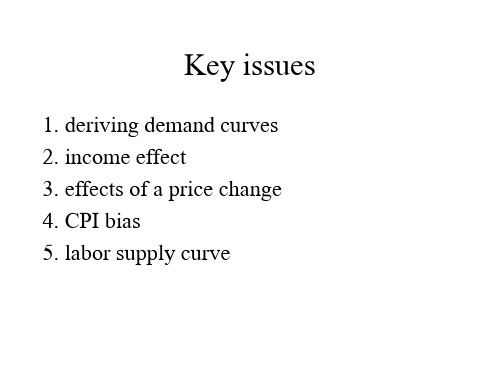
Income and substitution effects
price rise substitution effect
normal good
negative
inferior good
negative
income effect negative positive
Substitution and Income Effects with Normal Goods
Income and substitution effect with an inferior good
• substitution effect: opposite of price movement • income effect: same direction as price movement • Giffen good: good for which a decrease in its price
Averaging
• one way to average price increases: weight the good equally
• but do we really want to weight price increase of skateboards as much as that of automobiles?
Key issues
1. deriving demand curves 2. income effect 3. effects of a price change 4. CPI bias 5. labor supply curve
Deriving Demand Curves
• trace out the demand curve by holding income and the price of wine constant, and varying the price of beer
平狄克微观经济学课件英文01精品文档19页

Chapter 1: Preliminaries
Copyright © 2009 Pearson Education, Inc. Publishing as Prentice Hall • Microeconomics • Pindyck/Rubinfeld, 7e.
4 of 18
1.1 THE THEMES OF MICROECONOMICS
Theories and Models
In economics, explanation and prediction are based on theories. Theories are developed to explain observed phenomena in terms of a set of basic rules and assumptions.
Workers Workers also face constraints and make trade-offs. First, people must decide whether and when to enter the workforce. Second, workers face trade-offs in their choice of employment. Finally, workers must sometimes decide how many hours per week they wish to work, thereby trading off labor for leisure.
In a market economy, prices are determined by the interactions of consumers, workers, and firms. These interactions occur in markets—collections of buyers and sellers that together determine the price of a good.
【复旦大学本科讲义-平狄克微观经济学PPT】lecture07-英文版

of purchasers: h Dh(pX ; nX)
where nX gives the number of consumers who purchase X. Note: • We suppressed other prices and income. • Could also depend on who consumes the good. Circularity: • Market demand is sum of individual demands which in turn depend on
h Dh(pX ; pY, Ih) where consumers/households indexed by h=1,…,N
HORIZONTAL SUMMATION
Consumer Surplus
• Consumers buy goods because it makes them better off
MARKET DEMAND
WITH NETWORK EFFECTS
Demand dependence: • The utility of a good derived by a consumer depends on how many other
consumers buy/use the good • Consequently individual and market demand depends on aggregate number
market demand. • Key role of expectations: expected popularity of a “network good” critical in
ensuring its popularity. • “Chicken and egg” problem: how to sell the first unit when it has little/no
where nX gives the number of consumers who purchase X. Note: • We suppressed other prices and income. • Could also depend on who consumes the good. Circularity: • Market demand is sum of individual demands which in turn depend on
h Dh(pX ; pY, Ih) where consumers/households indexed by h=1,…,N
HORIZONTAL SUMMATION
Consumer Surplus
• Consumers buy goods because it makes them better off
MARKET DEMAND
WITH NETWORK EFFECTS
Demand dependence: • The utility of a good derived by a consumer depends on how many other
consumers buy/use the good • Consequently individual and market demand depends on aggregate number
market demand. • Key role of expectations: expected popularity of a “network good” critical in
ensuring its popularity. • “Chicken and egg” problem: how to sell the first unit when it has little/no
平狄克微观经济学课件(英文)06全

4 of 24
6.1 THE TECHNOLOGY OF PRODUCTION
The Short Run versus the Long Run
●short run Period of time in which quantities of one or more production factors cannot be changed.
As we move from point A on curve O1 to B on curve O2 to C on curve O3 over time, labor productivity increases.
7 of 24
Chapter 6: Production
6.2 PRODUCTION WITH ONE VARIABLE INPUT (LABOR)
The Slopes of the Product Curve
Figure 6.1
Production with One Variable Input
0
Average
Marginal
Product (q/L) Product (∆q/∆L)
—
—
1
10
10
10
10
2
10
30
15
20
3
10
60
20
30
4
10
80
20
20Hale Waihona Puke 51095
19
15
6
10
108
18
13
7
10
112
16
4
8
10
112
14
0
lecture05 Deriving Demand Curves 平狄克微观经济学英文课件

Substitution effect
• consumers substitute other, now relatively cheaper, goods for the one whose price rose
• direction of the effect is unambiguous
Income effect
How income changes shift demand curves
• hold prices fixed and vary income • increase in income causes
• shift of the demand curve • movement along income-consumption curve • movement along the Engel curve
• some goods must be normal: not all goods can be inferior
Income-Consumption Curves and Income Elasticities
Income elasticities may vary with income
Gail may view hamburger as • a normal good at a low income • an inferior good at a high income
Income and substitution effecห้องสมุดไป่ตู้s
price rise substitution effect
normal good
negative
inferior good
negative
chapter_3 Consumer Behavior 平狄克微观英文版课件

Indifference curves are convex because as more of one good is consumed, a consumer would prefer to give up fewer units of a second good to get additional units of the first one.
Chapter 1
Slide 9
Consumer Behavior
There are three steps involved in the study of consumer behavior.
3) Finally, we will combine consumer preferences and budget constraints to determine consumer choices.
Three Basic Assumptions 1) Preferences are complete. 2) Preferences are transitive. 3) Consumers always prefer more of any good to less.
Chapter 1
Slide 12
Each indifference curve in the map shows the market baskets among which the person is indifferent.
Chapter 1
Slide 19
Consumer Preferences
Indifference Curves
Chapter 1
Slide 18
Consumer Preferences
Chapter 1
Slide 9
Consumer Behavior
There are three steps involved in the study of consumer behavior.
3) Finally, we will combine consumer preferences and budget constraints to determine consumer choices.
Three Basic Assumptions 1) Preferences are complete. 2) Preferences are transitive. 3) Consumers always prefer more of any good to less.
Chapter 1
Slide 12
Each indifference curve in the map shows the market baskets among which the person is indifferent.
Chapter 1
Slide 19
Consumer Preferences
Indifference Curves
Chapter 1
Slide 18
Consumer Preferences
【复旦大学本科讲义-平狄克微观经济学PPT】lecture02-英文版
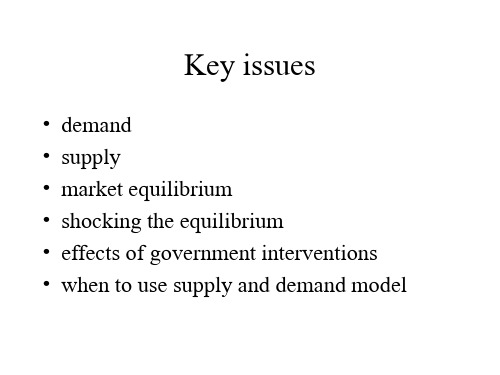
There is no "Law of Supply"
market supply curve may be upward sloping, vertical, horizontal, or downward sloping
Supply effects of other variables
shift in a variable other than price of pork causes the entire supply curve to shift
curves: Q1 = D1(P) Q2 = D2(P) • total quantity demanded = horizontal sum of quantity each consumer demands at each given price: Q = Q1 + Q2 = D1(P) + D2(P)
General supply function
Summing supply curves
total supply curve • horizontal summation of individual supply
curves • shows total quantity produced by all
• which affects foreign supply and total Japanese supply curve
Answer
1. show what the ban does to the foreign supply: ban prevents imports new foreign supply curve, Sf, lies on the vertical axis
平狄克微观经济学Externalities and Public GoodsPPT课件

©2005 Pearson Education, Inc.
Chapter 18
2
Externalities
Externalities arise between producers, between consumers, or between producers and consumers
Externalities are the effects of production and consumption activities not directly reflected in the market
q1 q*
©2005 Pearson Education, Inc.
Chapter 18
Repair Level
13
Ways of Correcting Market Failure
Assumption: The market failure is pollution
Output decision and emissions decision are independent
Additional cost to firm of controlling pollution Downward sloping because when emissions
are high, there is little cost to controlling them
Large reductions require costly changes in production process
©2005 Pearson Education, Inc.
Chapter 18
4
Externalities
平狄克微观经济学课件(英文)16

3 of 35
Chapter 16: Information, Market Failure, and the Role of Government
16.1
GENERAL EQUILIBRIUM ANALYSIS
Two Interdependent Markets—Moving to General Equilibrium
16.1
GENERAL EQUILIBRIUM ANALYSIS
Figure 16.2 Removing the Ethanol Tariff on Brazilian Exports
If U.S. tariffs on ethanol produced abroad were to be removed, Brazil would export much more ethanol to the United States, displacing much of the more expensive corn-based ethanol produced domestically. As a result, the price of ethanol in the U.S. would fall, benefiting U.S. consumers.
7 of 35
Copyright © 2009 Pearson Education, Inc. Publishing as Prentice Hall • Microeconomics • Pindyck/Rubinfeld, 7e.
Chapter 16: Information, Market Failure, and the Role of Government
●general equilibrium analysis Simultaneous determination of the prices and quantities in all relevant markets, taking feedback effects into account.
【复旦大学本科讲义-平狄克微观经济学PPT】common property-英文版
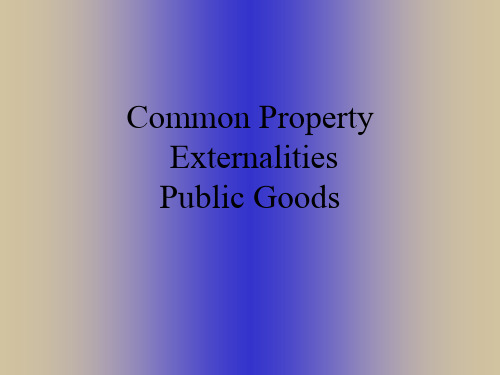
• Clean Air Act of 1990 sets national airquality standards for major pollutants: 0.12 parts per million (ppm)
• California Air Resources Board (CARB) has an even tighter standard: 0.09 ppm
externalities 5. common property 6. public goods
Externalities
externality occurs if • someone's consumption or production
activities hurt or help others outside a market • well-being of a consumer or production capability of a firm are affected directly by actions of other consumers or firms, rather than indirectly through changes in prices
Emissions Standards for Ozone
Monopoly and externalities
• monopoly output may be less than social optimum even with an externality
• competition is not necessarily better than a monopoly with an externality
Cost-benefit analysis
• California Air Resources Board (CARB) has an even tighter standard: 0.09 ppm
externalities 5. common property 6. public goods
Externalities
externality occurs if • someone's consumption or production
activities hurt or help others outside a market • well-being of a consumer or production capability of a firm are affected directly by actions of other consumers or firms, rather than indirectly through changes in prices
Emissions Standards for Ozone
Monopoly and externalities
• monopoly output may be less than social optimum even with an externality
• competition is not necessarily better than a monopoly with an externality
Cost-benefit analysis
微观经济学英文版第一章课件-PPT精品文档

Chapter 1
Slide 6
关于教材的使用(讲授章节 )
第一篇 导论:市场和价格(1-2)
第1章 绪论 第2章 供给与需求的基本原理
第二篇 生产者,消费者以及竞争性市场(3-9)
第3章 消费者行为
第4章 个别需求与市场需求(1-4) 第6章 生产
第7章 生产成本(1-4)
运用统计学和计量经济学的技术,理论可
Chapter 1
Slide 26
理论和模型 Theories and Models
微观经济分析 Microeconomic Analysis
理论的有效性(和有用性) Validating a Theory
在假设既定的前提下,理论的有效性取决 于预测(和解释)的质量. The validity of a theory is determined by the quality of its prediction, given the assumptions.
Unemployment
Chapter 1
Slide 17
绪论 Preliminaries
微观经济学和宏观经济学的联系 The Linkage Between Micro and Macroeconomics
微观经济学是宏观经济分析的基础 Microeconomics is the foundation of macroeconomic analysis 宏观经济学也涉及市场分析(行为分析) 宏观经济学(部分内容)是微观经济学的延伸
Chapter 1
Slide 29
实证和规范 Positive Versus Normative Analysis
微观经济学(平狄克、鲁宾费尔德)最新版(第六版) 英文原版PPTCh01_Pindyck
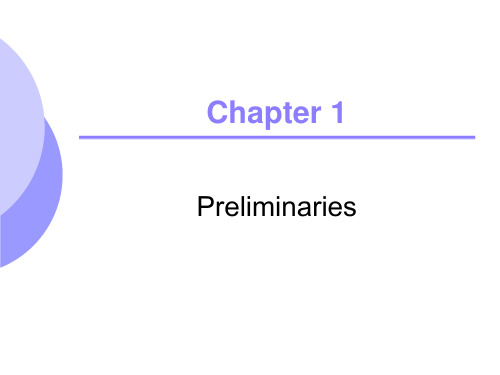
11
Theories and Models
Validating a Theory
The validity of a theory is determined by the quality of its prediction, given the assumptions Theories must be tested and refined Theories are invariably imperfect – but gives much insight into observed phenomena
©2005 Pearson Education, Inc.
Chapter 1
15
What is a Market?
Market Definition
Determination of the buyers, sellers, and range of products that should be included in a particular market
What choices do individuals make in terms of jobs or workplaces? How many hours do individuals choose to work?
Trade-off of labor and leisure
©2005 Pearson Education, Inc.
©2005 Pearson Education, Inc.
©2005 Pearson Education, Inc.
Chapter 1
8
Themes of Microeconomics
Prices
How are prices determined?
【复旦大学本科讲义-平狄克微观经济学PPT】General Equilibrium-英文版
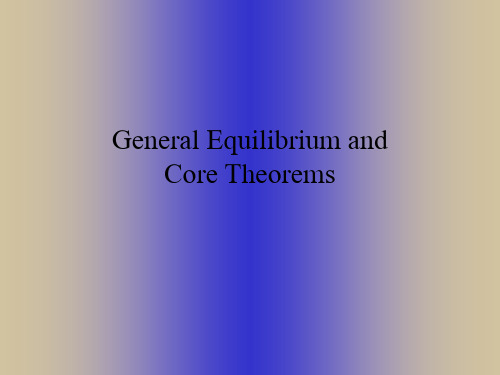
• through demand • through supply
• because output in one market is an input in another
Partial vs. General Equilibrium
• study equilibrium in several—but not all— markets simultaneously
• shock in one market has spillover effect in another market
• general-equilibrium analysis takes account of spillover, unlike partial-equilibrium analysis
Is it possible to pay Peter without robbing Paul?
General Equilibrium
• Magnitude of spillover effects • General vs. partial equilibrium models
Pareto-Efficient Equilibrium
• doing so is OK for small markets (hoola hoops)
General-equilibrium analysis
• study of how equilibrium is determined in all markets simultaneously an event in one market may have a spillover effect on other markets may be linked
• because output in one market is an input in another
Partial vs. General Equilibrium
• study equilibrium in several—but not all— markets simultaneously
• shock in one market has spillover effect in another market
• general-equilibrium analysis takes account of spillover, unlike partial-equilibrium analysis
Is it possible to pay Peter without robbing Paul?
General Equilibrium
• Magnitude of spillover effects • General vs. partial equilibrium models
Pareto-Efficient Equilibrium
• doing so is OK for small markets (hoola hoops)
General-equilibrium analysis
• study of how equilibrium is determined in all markets simultaneously an event in one market may have a spillover effect on other markets may be linked
- 1、下载文档前请自行甄别文档内容的完整性,平台不提供额外的编辑、内容补充、找答案等附加服务。
- 2、"仅部分预览"的文档,不可在线预览部分如存在完整性等问题,可反馈申请退款(可完整预览的文档不适用该条件!)。
- 3、如文档侵犯您的权益,请联系客服反馈,我们会尽快为您处理(人工客服工作时间:9:00-18:30)。
In a market economy, prices are determined by the interactions of consumers, workers, and firms. These interactions occur in markets—collections of buyers and sellers that together determine the price of a good.
Firms Firms also face limits in terms of the kinds of products that they can produce, and the resources available to produce them.
Copyright © 2009 Pearson Education, Inc. Publishing as Prentice Hall • Microeconomics • Pindyck/Rubinfeld, 7e.
A model is a mathematical representation, based on economic theory, of a firm, a market, or some other entity.
Theories and Models
In economics, explanation and prediction are based on theories. Theories are developed to explain observed phenomena in terms of a set of basic rules and assumptions.
● macroeconomics Branch of economics that deals with aggregate economic variables, such as the level and growth rate of national output, interest rates, unemployment, and inflation.
Copyright © 2009 Pearson Education, Inc. Publishing as Prentice Hall • Microeconomics • Pindyck/Rubinfeld, 7e.
2 of 18
Preliminaries
● microeconomics Branch of economics that deals with the behavior of individual economic units—consumers, firms, workers, and investors—as well as the markets that these units comprise.
1.1 THE THEMES OF MICROECONOMICS
Trade Offs
Consumers Consumers have limited incomes, which can be spent on a wide variety of goods and services, or saved for the future.
Chapter 1: Preliminaries
Copyright © 2009 Pearson Education, Inc. Publishing as Prentice Hall • Microeconomics • Pindyck/Rubinfeld, 7e.
3 of 18
Chapter 1: Preliminaries
CHAPTER
1
Preliminaries
Prepared by: Fernando & Yvonn Quijano
Copyright © 2009 Pearson Education, Inc. Publishing as Prentice Hall • Microeconomics • Pindyck/Rubinfeld, 7e.
4 of 18
1.1 THE THEMES OF MICROECONOMICS
Prices and Markets
Microeconomics describes how prices are determined.
In a centrally planned economy, prices are set by the government.
CHAPTER 1 OUTLINE
1.1 The Themes of Microeconomics 1.2 What Is a Market? 1.3 Real versus Nominal Prices 1.4 Why Study Microeconomics?
Chapter 1: Preliminaries
Workers Workers also face constraints and make trade-offs. First, people must decide whether and when to enter the workforce. Second, workers face trade-offs in their choice of employment. Finally, workers must sometimes decide how many hours per week they wish to work, thereby trading off labor for leisure.
Chapter 1: Preliminaries
Copyright © 2009 Pearson Education, Inc. Publishing as Prentice Hall • Microeconomics • Pindyck/Rubinfeld,HE THEMES OF MICROECONOMICS
Firms Firms also face limits in terms of the kinds of products that they can produce, and the resources available to produce them.
Copyright © 2009 Pearson Education, Inc. Publishing as Prentice Hall • Microeconomics • Pindyck/Rubinfeld, 7e.
A model is a mathematical representation, based on economic theory, of a firm, a market, or some other entity.
Theories and Models
In economics, explanation and prediction are based on theories. Theories are developed to explain observed phenomena in terms of a set of basic rules and assumptions.
● macroeconomics Branch of economics that deals with aggregate economic variables, such as the level and growth rate of national output, interest rates, unemployment, and inflation.
Copyright © 2009 Pearson Education, Inc. Publishing as Prentice Hall • Microeconomics • Pindyck/Rubinfeld, 7e.
2 of 18
Preliminaries
● microeconomics Branch of economics that deals with the behavior of individual economic units—consumers, firms, workers, and investors—as well as the markets that these units comprise.
1.1 THE THEMES OF MICROECONOMICS
Trade Offs
Consumers Consumers have limited incomes, which can be spent on a wide variety of goods and services, or saved for the future.
Chapter 1: Preliminaries
Copyright © 2009 Pearson Education, Inc. Publishing as Prentice Hall • Microeconomics • Pindyck/Rubinfeld, 7e.
3 of 18
Chapter 1: Preliminaries
CHAPTER
1
Preliminaries
Prepared by: Fernando & Yvonn Quijano
Copyright © 2009 Pearson Education, Inc. Publishing as Prentice Hall • Microeconomics • Pindyck/Rubinfeld, 7e.
4 of 18
1.1 THE THEMES OF MICROECONOMICS
Prices and Markets
Microeconomics describes how prices are determined.
In a centrally planned economy, prices are set by the government.
CHAPTER 1 OUTLINE
1.1 The Themes of Microeconomics 1.2 What Is a Market? 1.3 Real versus Nominal Prices 1.4 Why Study Microeconomics?
Chapter 1: Preliminaries
Workers Workers also face constraints and make trade-offs. First, people must decide whether and when to enter the workforce. Second, workers face trade-offs in their choice of employment. Finally, workers must sometimes decide how many hours per week they wish to work, thereby trading off labor for leisure.
Chapter 1: Preliminaries
Copyright © 2009 Pearson Education, Inc. Publishing as Prentice Hall • Microeconomics • Pindyck/Rubinfeld,HE THEMES OF MICROECONOMICS
